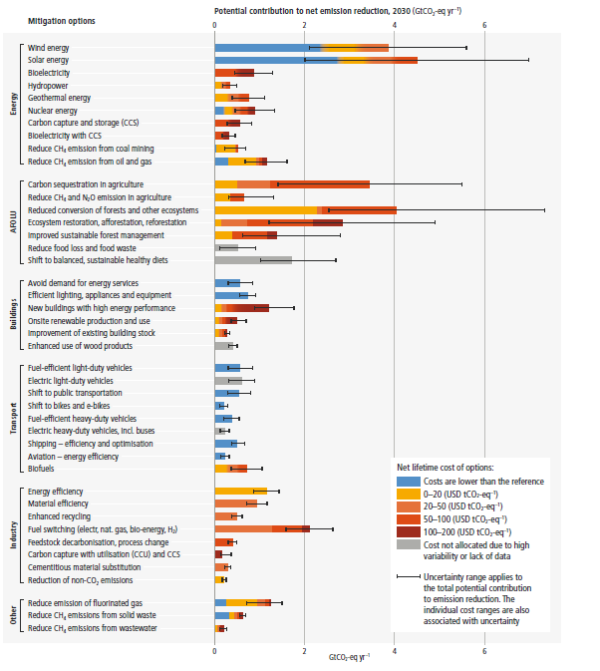Peak emissions before 2025: key messages from the IPCC’s Synthesis Report
The IPCC's final report of its Sixth Assessment Cycle is a comprehensive overview of the state of climate change and a roadmap for action in this critical. Our experts pull out the key messages.
Share

Yesterday the Intergovernmental Panel on Climate Change (IPCC) released the final report of its Sixth Assessment Cycle, a synthesis of all three of its working group outputs and the special reports on oceans, land and on 1.5°C.
It’s the last comprehensive overview of the state of climate change from the IPCC we will have for a while and the findings can’t be understated.
We are in a crisis of our own making. Flooding, storms, droughts, and fires are already taking lives and displacing thousands of people. Small island developing states and least developed countries are being disproportionately affected, and widespread loss and damage from climate change is a reality today.
Risk levels across the board have been revised upward since the last IPCC cycle. Sea level rise, ecosystem loss, species extinction – the impacts of climate change are reaching us earlier than we thought as the world continues to warm. Above 1.5°C they will become the new normal.
We know the solutions, many of them are low or no cost, but governments are not acting with the speed necessary. The IPCC is clear, the choices and actions implemented in this decade will have impacts now and for thousands of years into the future. Current policies have us headed for warming of 3°C. Every year that we delay emissions cuts, we’re making our task to limit warming to 1.5°C more difficult.
But what are the implications of a rapidly closing window to limit warming to 1.5°C?
The critical decade for action
More than anything the 1.5°C limit sets out an urgency and immediacy for emissions reductions. The timing of these reductions frames the 2020s as the critical decade for climate action.
1.5°C pathways are defined by deep and sustained emissions cuts in the very near-term – roughly halving emissions by 2030. Such rapid cuts this decade, and next, are needed to put us on a path to net zero CO2 emissions by 2050, followed by greenhouse gases in the second half of the 21st century, as set out in the Paris Agreement.
The benefits are clear. By halving our emissions this decade we can get on track to stop warming by 2050. We will be able to avoid the worst climate impacts, buy time to adapt and give ourselves the best chance of not triggering irreversible tipping points in ecosystems around the world.
It will be the difference between rising temperatures being something we can stop in our lifetimes, or an existential threat we pass on to our children.
Peaking emissions before 2025
We aren’t on track at all to achieve these reductions. Investment in mitigation and adaptation combined is still being outstripped by investment in fossil fuels. But we do know what has to happen first. Global greenhouse gas emissions have to peak before 2025.
This doesn’t mean every country needs to be reducing emissions by 2025, and developing countries with very low per capita emissions may see increases still for some time. But on aggregate this is what needs to happen.
This requires global leadership by the big emitters, the G20 countries, accounting for about three quarters of global greenhouse gas emissions. All eyes will be on the outcome of their summit later this year.
At the start of 2022, there was some hope that we had started on a downward trajectory, but unfortunately emissions have rebounded since the COVID-19 pandemic to reach new records – largely from coal-fired power. While some countries have managed to peak their emissions, they aren’t yet reducing them quickly enough to make up for the ones who haven’t.
Other countries are on a knife’s edge – they could be peaking their emissions – but decisions made in the here and now, especially those concerning fossil fuel expansion and climate finance from rich nations, are the axis on which our ability to limit warming to 1.5°C turns. We’re on a deadline – and peaking emissions is the first hurdle that we need get over.
At the end of this year the Global Stocktake, a process administered by the UNFCCC to take stock of countries’ climate action under the Paris Agreement, will conclude. This will be vital to the ‘ratcheting up’ of emissions reductions. Peaking could be one of the key signals to the world that this process has delivered.
What more do we need to do to limit warming to 1.5°C?
Looking at the scenarios that limit warming to 1.5°C, we see common features that can be communicated to policymakers.
OECD countries will need to phase coal out of electricity generation before 2030, with gas following to be effectively phased out by 2035. In developing countries, the dates are 2040 and 2045 respectively.
Electrification of transport, buildings, and industry needs to happen quickly. Removing fossil fuel subsidies will be absolutely critical and can reduce emissions by up to 10% by 2030. Demand-side reduction efforts are also particularly cost-effective and could reduce emissions between 40-70% by 2050.
More than anything though, renewables are the foundation of our ability to halve emissions by 2030. They are outstripping fossil fuels on cost and are the fastest growing source for energy out there, with clear benefits for energy access, security and health.
We’re very fond of this graph from the Working Group III report, showing that half the 2030 emissions gap can be closed with wind and solar, costing less that USD 20 per tonne of CO2e (for reference, the EU emissions trading scheme has had a carbon price above 90 Euros since the start of 2023).
The final piece is climate finance, a critical enabler for accelerated climate action. The money is there, but developed countries, multilateral institutions and the private sector need to get serious about shifting the trillions. A profound increase in international climate finance, and improved access, is needed to support developing countries that continue to experience the biggest gaps. We all stand to lose if this doesn’t happen.
Since the Paris Agreement, 1.5°C has become a rallying cry for climate action around the world. It stands for all that we can save, for the protection of people’s homes and cultures. And it stands for decisive, and fast action now.
“There is a rapidly closing window of opportunity to secure a liveable and sustainable future for all (very high confidence).”
– IPCC AR6 Synthesis Report













